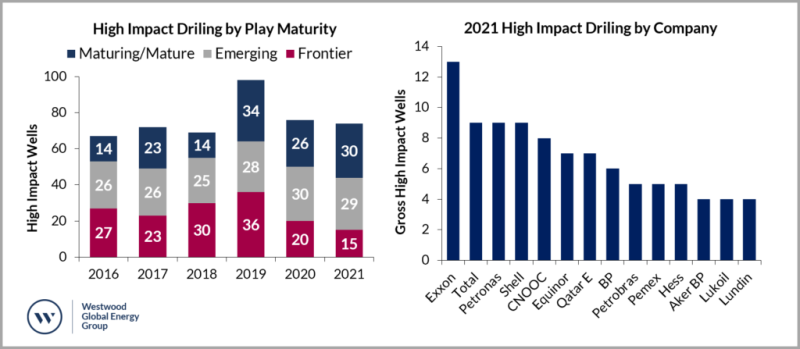High-impact drilling activity around the world last year added a low number of barrels to future supplies.
The results from a group of 74 wells that Westwood Global Energy Group had said could deliver large discoveries found only about a third of the oil and gas discovered by the wells on the data and consulting firm’s 2020 list.
With the recent jump in oil and gas prices on tight supplies, exploration success has an impact that goes beyond those in the upstream business.
The number of high-impact wells drilled is in line with totals in recent years, but the locations chosen show a shift away from high-risk frontier locations to mature areas where the odds of finding a well that can be quickly put into production are higher.
“Frontier exploration drilling fell to the lowest level ever recorded by Westwood (since 2008) with only 15 frontier wells completing and only one making a potentially modest-sized commercial discovery,” the study said. It added that those choices “show that the industry is less concerned with long-term renewal and is instead focused on quicker returns.”

Nearly half of the discoveries were in Russia, highlighted by the largest find of the year—the Zinichvev discovery. The Arctic field was discovered by a Rosneft-BP joint venture on the Taymyr Peninsula, a prolific gas-producing area in Eastern Siberia. Westwood estimates the field holds about 13 Tcf of recoverable gas (2.3 billion BOE).
That find was also in keeping with another 2021 trend: Gas represented nearly two-thirds of what was found.
The largest discovery outside Russia was the Baleine prospect off the Ivory Coast. Eni is the operator on what it said was the first deepwater discovery there since 2001. The company estimated 1.5 billion bbl of oil and 1.8 Tcf of gas in the ground, with prospects for more nearby.
This year the report used the word “billion” sparingly compared to last year’s report.
It was used to describe four wells drilled off Suriname and Guyana that added a total of about 1 billion BOE in what was classified as emerging-play exploration.
Results were even lower in mature plays where only seven of the 13 high-impact wells yielded more than 100 million BOE.
Past results also show year-to-year variations within this small sample. A chart showed the annual totals range from about 5 billion bbl in 2016 to 19 billion bbl last year.

Success rates of frontier discoveries also vary markedly from year to year with a range from 0 to 10%.
This year’s total indicates the industry will be taking about the same number of drilling chances with a potential payoff ranging from 30 billion BOE to 6 billion BOE when risk is factored into the total.
Westwood said it is hard to predict how many high-impact wells will be drilled in 2023.
“The 2022 exploration program is dominated by commitment wells on licenses acquired prior to 2020. Things may change in 2023 and beyond, as current portfolios are drilled out and if acreage is not renewed in response to energy transition pressures,” the report said.


